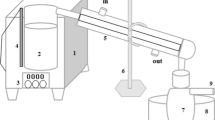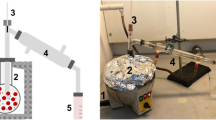Abstract
Suitable disposal pathways of waste plastics and coal fly ash have yet not been established which is a matter of great environmental concern. Waste low-density polyethylene (LDPE) and high-density polyethylene (HDPE) were degraded using a semi-batch reactor along with acid or alkali modified fly ash catalyst. The high yield of liquid fuel product (about 87.24 wt%) was achieved for low-density polyethylene at a polymer and catalyst ratio of 25 w/w. About 96% conversion was found with very few amount of gaseous fuels. Both of the waste plastics were degraded at 400–450 °C. The liquid products were analyzed using Fourier-transform infrared spectroscopy (FTIR), nuclear magnetic resonance (1H, 13C, and DEPT-135 NMR), and gas chromatography–mass spectrometry (GC–MS). Fly ash is an efficient catalyst to degrade waste plastic into light weight liquid (gasoline and kerosene) hydrocarbons. The NMR results accompanied by GC–MS data ensure that obtained fuels contain both aliphatic (saturated and unsaturated) and aromatic hydrocarbons. This plastic-to-fuel technology should be commercialized owing to be profitable and eco-friendly.
Graphic abstract







Similar content being viewed by others
References
Karagoz, S., Yanik, J., Ucar, S., et al. 2002. Catalytic coprocessing of low-density polyethylene with VGO using metal supported on activated carbon. Energy and Fuels 16 (5): 1301–1308. https://doi.org/10.1021/ef020064q.
Aguado, J., Sotelo, J.L., Serrano, D.P., et al. 1997. Catalytic conversion of polyolefins into liquid fuels over MCM-41: Comparison with ZSM-5 and amorphous SiO2−Al2O3. Energy and Fuels 11: 1225–1231. https://doi.org/10.1021/ef970055v.
Kumar, S., Singh, R.K. 2011. Recovery of hydrocarbon liquid from waste high density polyethylene by thermal pyrolysis. Brazilian Journal of Chemical Engineering 28 (4): 659–667. https://doi.org/10.1590/S0104-66322011000400011.
Yan, G., Jing, X., Wen, H., et al. 2015. Thermal cracking of virgin and waste plastics of PP and LDPE in a semibatch reactor under atmospheric pressure. Energy and Fuels 29: 2289–2298. https://doi.org/10.1021/ef502919f.
DeNeve, D., Joshi, C. Samdani, A., et al. 2017. Optimization of an appropriate technology based process for converting waste plastic in to liquid fuel via thermal decomposition. Journal of Sustainable Development 10 (2): 116–124. https://doi.org/10.5539/jsd.v10n2p116.
Anene, A.F., Fredriksen, S.B., Saetre, K.A., et al. 2018. Experimental study of thermal and catalytic pyrolysis of plastic waste components. Sustainability 10 (11): 3979. https://doi.org/10.3390/su10113979.
Serrano, D.P., Aguado, J., Escola, J.M. 2012. Developing advanced catalysts for the conversion of polyolefinic waste plastics into fuels and chemicals. ACS Catalysis 2 (9): 1924–1941. https://doi.org/10.1021/cs3003403.
Miandad, R., Barakat, M.A. Rehan, M., et al. 2017. Plastic waste to liquid oil through catalytic pyrolysis using natural and synthetic zeolite catalysts. Waste Management 69: 66–78. https://doi.org/10.1016/j.wasman.2017.08.032.
Miskolczi, N., Bartha, L., Deak G. 2006. Thermal degradation of polyethylene and polystyrene from the packaging industry over different catalysts into fuel-like feed stocks. Polymer Degradation Stability 91 (3): 517–526. https://doi.org/10.1016/j.polymdegradstab.2005.01.056.
Lin, Y.H., Yang, M.H. Yeh, T.F., et al. 2004. Catalytic degradation of high density polyethylene over mesoporous and microporous catalysts in a fluidised-bed reactor. Polymer Degradation and Stability 86: 121–128. https://doi.org/10.1016/j.polymdegradstab.2004.02.015.
Losey, D.J., Sihvonen, S.K., Veghte, D.P., et al. 2018. Acidic processing of fly ash: chemical characterization, morphology, and immersion freezing. Environmental Science: Processes and Impacts 20: 1581–1592. https://doi.org/10.1039/C8EM00319J.
Qiu, M., Wang, Y., Niu, M., et al. 2016. Effects of activation and modification on the microstructure and composition of fly ash. Chemical Science International Journal 14 (4): 1–6. https://doi.org/10.9734/ACSJ/2016/26348.
Benedetti, M., Cafiero, L., Angelis, D.D., et al. 2017. Pyrolysis of WEEE plastics using catalysts produced from fly ash of coal gasification. Frontiers of Environmental Science and Engineering 11 (5): 11. https://doi.org/10.1007/s11783-017-0998-3.
Na, J.G., Jeong, B.H., Chung, S.H., et al. 2006. Pyrolysis of low-density polyethylene using synthetic catalysts produced from fly ash. Journal of Material Cycles and Waste Management 8 (2): 126–132. https://doi.org/10.1007/s10163-006-0156-7.
Mondal, B.K., Islam, M.N., Hossain, M.E., et al. 2019. Microstructural and mineralogical properties of acid and alkali activated coal fly ash. Journal of Advanced Chemical Sciences 5 (1): 612–614. https://doi.org/10.30799/jacs.201.19050102.
Siddiqui, M.N. 2009. Conversion of hazardous plastic wastes into useful chemical products. Journal of Hazardous Materials 167: 728–735. https://doi.org/10.1016/j.jhazmat.2009.01.042.
Roy, G.K. 2013. A novel process of converting polyethylene to gasoline, middle distillate and heavy oil through hydropyrolysis route. International Journal of Energy Engineering 3 (3): 147–157. https://doi.org/10.5923/j.ijee.20130303.04.
Sarker, M., Rashid, M.M., Molla, M. 2012. First waste plastic conversion into liquid fuel by using muffle furnace through reactor. International Journal of Energy Engineering 2 (6): 293–303. https://doi.org/10.5923/j.ijee.20120206.04.
Artetxe, M., Lopez, G., Amutio, M., et al. 2012. Light olefins from HDPE cracking in a two-step thermal and catalytic process. Chemical Engineering Journal 207: 27–34. https://doi.org/10.1016/2012.06.105.
Silva, S.L., Silva, A.M.S., Ribeiro, J.C., et al. 2011. Chromatographic and spectroscopic analysis of heavy crude oil mixtures with emphasis in nuclear magnetic resonance spectroscopy: A review. Analytica Chimica Acta 707: 18–37. https://doi.org/10.1016/j.aca.2011.09.010.
Jeon, C.H., Park, C.K., Na, B.K., et al. 2017. Properties of gasoline stored in various containers. Energies 10 (9): 1307. https://doi.org/10.3390/en10091307.
Hasan, M.U., Bukhari, A., Ali, M.F. 1985. Structural characterization of Saudi Arabian medium crude oil by n.m.r. spectroscopy. Fuel 64: 839–841. https://doi.org/10.1016/0016-2361(85)90020-1.
Mullen, C.A., Strahan, G.D., Boateng, A.A. 2009. Characterization of various fast-pyrolysis bio-oils by NMR spectroscopy. Energy and Fuels 23 (5): 2707–2718. https://doi.org/10.1021/ef801048b.
Negahdar, L., Gonzalez-Quiroga, A., Otyuskaya, D., et al. 2016. Characterization and comparison of fast pyrolysis bio-oils from pinewood, rapeseed cake, and wheat straw using 13C NMR and comprehensive GC × GC. ACS Sustainable Chemistry and Engineering 4 (9): 4974–4985. https://doi.org/10.1021/acssuschemeng.6b01329.
Rakhmatullin, I.Z., Efimov, S.V., Tyurin, V.A., et al. 2018. Application of high resolution NMR (1H and 13C) and FTIR spectroscopy for characterization of light and heavy crude oils. Journal of Petroleum Science and Engineering 168: 256–262. https://doi.org/10.1016/j.petrol.2018.05.011.
Elbaz, A.M., Gani, A., Hourani, N., et al. 2015. TG/DTG, FT-ICR mass spectrometry, and NMR spectroscopy study of heavy fuel oil. Energy and Fuels 29 (12): 7825–7835. https://doi.org/10.1021/acs.energyfuels.5b01739.
Bansal, V., Krishna, G.J., Chopra, A., et al. 2007. Detailed hydrocarbon characterization of RFCC feed stocks by NMR spectroscopic techniques. Energy and Fuels 21 (2): 1024–1029. https://doi.org/10.1021/ef060268x.
Gomez, N.A., Abonia, R. Cadavid, H., et al. 2011. Chemical and spectroscopic characterization of a vegetable oil used as dielectric coolant in distribution transformers. Journal of the Brazilian Chemical Society 22 (12): 2292–2303. https://doi.org/10.1590/S0103-50532011001200009.
Zhu, Y., Tremblay, A.Y., Facey, G.A., et al. 2015. Petroleum diesel and biodiesel fuels used in a direct hydrocarbon phosphoric acid fuel cell. J Fuels 1: 1–9. https://doi.org/10.1155/2015/915015.
Sriningsih, W., Saerodji, M.G., Trisunaryanti, W., et al. 2014. Fuel production from LDPE plastic waste over natural zeolite supported Ni, Ni-Mo, Co and Co-Mo metals. Procedia Environmental Sciences 20: 215–224. https://doi.org/10.1016/j.proenv.2014.03.028.
Sharma, B.K., Moser, B.R., Vermillion, K.E., et al. 2014. Production, characterization and fuel properties of alternative diesel fuel from pyrolysis of waste plastic grocery bags. Fuel Processing Technology 122: 79–90. https://doi.org/10.1016/j.fuproc.2014.01.019.
Panda, A.K., Singh, R.K., Mishra D.K. 2010. Thermolysis of waste plastics to liquid fuel: A suitable method for plastic waste management and manufacture of value added products—a world prospective. Renewable and Sustainable Energy Reviews 14 (1): 233–248. https://doi.org/10.1016/j.rser.2009.07.005.
Achilias, D.S., Roupakias, C., Megalokonomos, P., et al. 2007. Chemical recycling of plastic wastes made from polyethylene (LDPE and HDPE) and polypropylene (PP). Journal of Hazardous Materials 149: 536–542. https://doi.org/10.1016/j.jhazmat.2007.06.076.
Geyer, R., Jambeck, J.R., Law, K.L. 2017. Production, use, and fate of all plastics ever made. Science Advances 3 (7): 1–5. https://doi.org/10.1126/sciadv.1700782.
Khan, A., Nawaz, K., Usama, M., Ashraf Z. 2015. Feasibility study of municipal plastic waste for power generation in Lahore city, Pakistan. Journal of Chemical Engineering and Process Technology 6 (2): 229. https://doi.org/10.4172/2157-7048.1000229.
Islam, M.S. 2012. Prospects and challenges of plastic industries in Bangladesh. Journal of Chemical Engineering 26 (1): 16–21. https://doi.org/10.3329/jce.v26i1.10176.
Yao, Z.T., Xia, M.S., Sarker, P.K., et al. 2014. A review of the alumina recovery from coal fly ash, with a focus in China. Fuel 120 (15): 74–85. https://doi.org/10.1016/j.fuel.2013.12.003.
Ge, J.C., Yoon, S.K., Choi, N.J. 2018. Application of fly ash as an adsorbent for removal of air and water pollutants. Applied Science 8 (7): 1116–1139. https://doi.org/10.3390/app8071116.
Acknowledgements
To give instrumental support, the authors gratefully acknowledge the Bangladesh Council of Scientific, and Industrial Research (BCSIR), Dhaka, Bangladesh, and Wazed Miah Science Research Centre, Jahangirnagar University, Saver, Bangladesh.
Funding
No endowment had been received from any donator in the public, commercial, or specific grant commission for this investigation.
Author information
Authors and Affiliations
Corresponding author
Ethics declarations
Conflict of interest
The authors declared that there is no conflicts of interest.
Additional information
Publisher's Note
Springer Nature remains neutral with regard to jurisdictional claims in published maps and institutional affiliations.
Electronic supplementary material
Below is the link to the electronic supplementary material.
Rights and permissions
About this article
Cite this article
Mondal, B.K., Guha, F. & Abser, M.N. Waste plastics-to-fuel using fly ash catalyst. Waste Dispos. Sustain. Energy 3, 13–19 (2021). https://doi.org/10.1007/s42768-020-00058-5
Received:
Revised:
Accepted:
Published:
Issue Date:
DOI: https://doi.org/10.1007/s42768-020-00058-5




